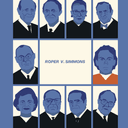

In his May 20 column in the Sunday New York Times, Pulitzer Prize winning columnist Nicholas Kristof (pictured, left) focused national attention on the troubling case of California death-row prisoner, Kevin Cooper (pictured, right) and the disturbing evidence suggesting that San Bernardino police planted blood and other evidence to frame him for murder. Kristof joined DPIC Executive Director Robert Dunham for a Discussions with DPIC podcast to talk about his recent column, Was Kevin Cooper Framed for Murder?, and how police came to focus on a 155-pound Black man as the sole suspect in a grizzly quadruple murder, despite physical and eyewitness evidence pointing to three white men, including one already convicted murderer, as the perpetrators.
Kristof explained how an opinion by a federal judge led him to write about the case: “What really struck me about [Cooper’s case] was that you had a number of federal judges who not only argued that there was doubt about his innocence, but simply argued that, look, he is innocent, he is framed by the sheriff’s office. And one very well respected Ninth Circuit judge, William Fletcher, came out and said he is framed by the San Bernardino County Sheriff’s Office, and wrote a hundred-page judicial opinion about that, and that just doesn’t happen in the law.”
Kristof says that his piece on Cooper, the longest column in New York Times history, was also inspired by his own failure, and that of the news media at large, to adequately cover the possible innocence of Texas prisoner Cameron Willingham, who was executed in 2004. Willingham’s case garnered a great deal of media attention only after he was executed.
“I think Kevin Cooper is innocent,” Kristof said, and “I want to write while there’s still time to affect the outcome.”
As he does in his column, Kristof describes the rampant irregularities in Cooper’s case that led him to conclude that Cooper had been framed, but he also talks in the podcast about the broader systemic problems that lead to wrongful convictions, especially in cases involving defendants of color.
Kristof pointed to the lack of accountability for official misconduct as one of most important systemic issues. “There have to be consequences for police or prosecutors when they engage in this kind of misconduct,” he said. “Too often, there are no consequences. We understand that there have to be consequences for bank robbery or murder, but there also have to be consequences for police officers who perjure themselves or sheriff’s deputies who plant evidence.”
Finally, Kristof explains how Cooper’s case is emblematic of other problems: “The reason I wrote about the Cooper case is not just because of the injustice, I believe, to one man, but more broadly, because it’s a window into the way the criminal justice system is periodically just plain broken, especially with regard to defendants of color or indigent defendants in really sensational cases. Sometimes the system works and sometimes it doesn’t, but it shouldn’t be a game of lottery when people are arrested and charged with capital offenses.”
Nicholas Kristof, Was Kevin Cooper Framed for Murder?, The New York Times, May 17, 2018; Podcast posted by DPIC, May 29, 2018.
Listen to Discussions with DPIC: Columnist Nicholas Kristof on The Framing of Kevin Cooper.

